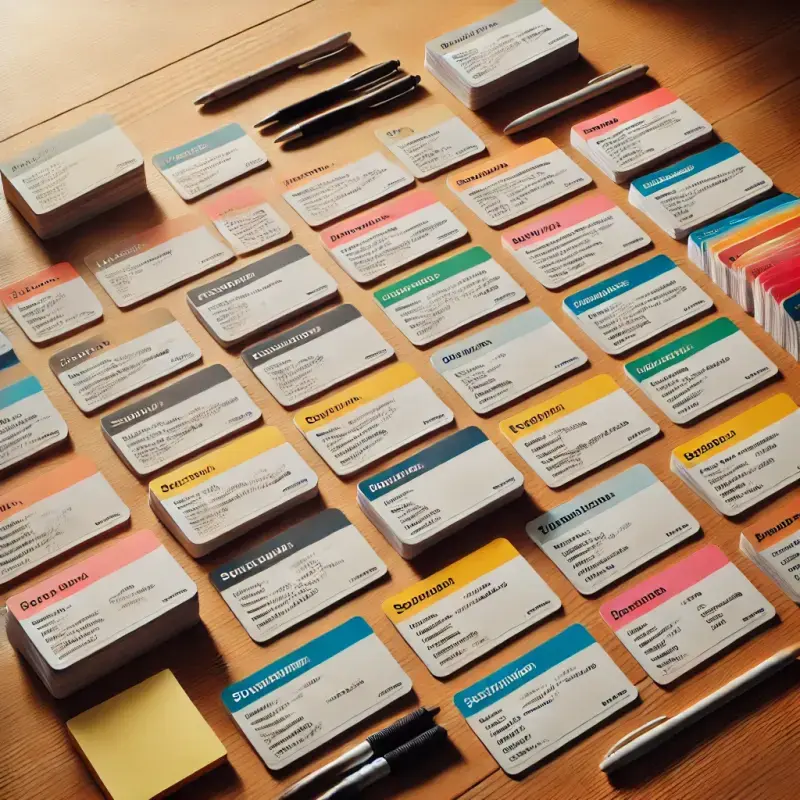Effective Methods for Using Flashcards to Master New Terms
Flashcards are among the most versatile and effective tools for mastering new terms, whether for academic study, professional growth, or personal enrichment. They serve as a dynamic method to enhance memory, simplify complex ideas, and make learning engaging. However, the effectiveness of flashcards depends largely on how they are created and used. This guide will explore practical steps for designing effective flashcards and strategies to maximize their potential in your learning process.
Why Flashcards Are Effective
Flashcards utilize active recall, a memory technique where the learner retrieves information from memory, reinforcing neural connections. This method contrasts with passive review, like re-reading notes, which is less effective for long-term retention. Additionally, flashcards integrate spaced repetition, a scientifically backed strategy where information is reviewed at increasing intervals to enhance memory durability.
By combining active recall with spaced repetition, flashcards support deeper learning, making them ideal for subjects requiring precise understanding of terms, such as languages, science, or history.
Creating Effective Flashcards
1. Define Your Goals
Before designing flashcards, clarify your purpose. Are you memorizing vocabulary, mastering scientific terms, or learning business jargon? Knowing your goals will help you focus on the most critical information and structure your flashcards effectively.
2. Keep Cards Simple
Each card should focus on one concept to avoid cognitive overload. For example:
- Front: Photosynthesis
- Back: The process by which green plants and some other organisms use sunlight to synthesize foods from carbon dioxide and water.
This simplicity makes it easier to recall and associate terms with definitions or explanations.
3. Use Clear and Concise Language
Avoid long-winded explanations. Use precise definitions and avoid unnecessary complexity. Clear language improves focus and aids understanding.
4. Incorporate Visual Elements
While you cannot include images of people, diagrams, icons, and symbols can make flashcards more engaging. For example, a flashcard for "ion" in chemistry could include a small diagram of a charged particle to enhance recall.
5. Utilize Both Sides Effectively
The front of the card should contain the question or term, while the back should provide the answer or explanation. Avoid cramming too much information onto a single side, as this can detract from the card's usability.
6. Categorize for Clarity
Organize your flashcards into categories or themes, such as “Biology Terms” or “French Vocabulary.” This approach makes it easier to study related concepts and builds connections between terms.
How to Use Flashcards Effectively
1. Prioritize Active Recall
When reviewing flashcards, challenge yourself to recall the information before flipping the card. This practice strengthens memory and builds confidence in your understanding of the terms.
2. Apply Spaced Repetition
Use a spaced repetition schedule to review flashcards at strategically timed intervals. Applications like Anki or physical card systems with separate compartments can help you implement this technique seamlessly.
For instance, review a card immediately after learning it, then a day later, a week later, and so on, gradually increasing the time between reviews as your familiarity grows.
3. Shuffle Regularly
Shuffling your flashcards prevents memorizing the sequence rather than the content. Randomization ensures that your brain recalls terms based on knowledge rather than predictable order.
4. Engage in Active Writing
For more complex terms, write out explanations on a separate sheet after reviewing each card. Writing reinforces memory through additional engagement and clarifies any lingering confusion.
5. Test Yourself in Context
Go beyond rote memorization by testing yourself with flashcards in practical contexts. For instance, use flashcards with foreign language vocabulary to form sentences or quiz yourself on historical terms within timelines.
Digital vs. Physical Flashcards
Both digital and physical flashcards have unique advantages:
- Physical Flashcards: Hands-on interaction with physical cards can aid tactile learners. They are customizable, allowing for personal touches such as sketches or handwritten notes.
- Digital Flashcards: Applications like Quizlet or Anki provide convenient options for on-the-go learning. Features like multimedia integration and automatic spaced repetition schedules enhance learning efficiency.
Choose the format that aligns with your learning style and goals, or use a combination of both for maximum flexibility.
